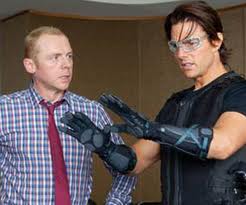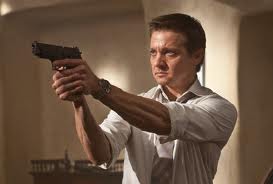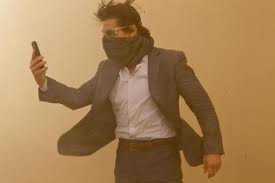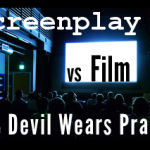Really, any aspiring screenwriter, whether they’re writing action adventure movies or romantic comedies, should watch the latest installment in the Mission Impossible franchise. Yes, it’s that good.
Regular readers of Scribe Meets World might be wondering why I haven’t compared the Mission Impossible 4 screenplay to the version released in theaters. I would love to, but I haven’t been able to find a copy of the script. It’s still under lock and key, probably guarded by the IMF itself, even though the movie’s already had a worldwide release.
I do know however, from this article on Collider.com, that Brad Bird filmed the movie with the idea that Ethan’s wife was dead. But the director rethought the issue…
“Well, we were well into the film thinking that she had been killed, and filmed quite a bit of the film thinking that she wasn’t around, and we just kept thinking that that kind of cast the previous movie in a negative light because it’s kind of like all that stuff that he went through to keep her alive in the last one didn’t ultimately amount to anything.”
“Simon Pegg mentioned that it was kind of like the feeling that you had about Aliens after seeing Alien 3, where she goes through unbelievable hell to save a couple of people, and then both of them died before the third movie.”
…proving once again why every movie is instantly better the minute Simon Pegg is cast in it. So that’s one change from the script.
Even without being able to compare MI4’s screenplay to its film version, there’s still plenty of action writing tips to learn if you study the movie with an analytical eye, assessing each of its components to see why it worked so well. That’s what I’ve done here.
In Ghost Protocol’s plot points, I wrote that Mission: Impossible 4 made action writing look easy–and if you study these screenwriting tips, you’ll see that a lot of them are almost kind of obvious, if you stop to think about it.
But most amateur screenwriters don’t stop to think about it. They leap into their draft, hoping to save the world with high-speed car chases, explosions, and fake identities. But you’re not going to snag a mega star like Tom Cruise just by writing an action movie with a compelling hero, high stakes, and thrilling action set pieces.
You have to write an action movie which stands out from the crowd. These tips should help you accomplish just that. If you follow them, you should have a blueprint for an action movie which might even get Mr Cruise’s attention.
To make the most of these action writing tips, you should have clear idea of your hero, his goal, and his antagonist. At the very least, you should have a bare-bones script outline with the 8 essential plot points, but ideally, you’d have a fleshed out story outline (for more on story outlines and beat sheets, read A Script Outline: A Must Have to Write, Edit and Sell Your Screenplay). Compare the beats in your story outline with the action writing tips below and refine your outline as necessary.
Good luck! I hope that after reading this article on how to write an action movie, you’ll say to yourself, “screenwriting mission: accomplished!”
Action Movie Screenwriting Tip #1: Save the cat…for another purpose
This action movie screenwriting tip won’t make much sense unless you’re familiar with Blake Snyder’s screenwriting guide, Save the Cat. Blake’s book is a great introduction to screenwriting basics, and I highly recommend it if you want an overview of the process, shared in an encouraging and motivational tone.
Anyway, the title of the book comes from Blake’s concept of “saving the cat,” which is basically having the hero do something in the first act which gets the audience to like him and root for him to win. That activity could be something nice and selfless like saving a cat. (For my corollary rule, “don’t kill the dog,” read screenwriting tip #4 from Salt and screenwriting tip #2 from Taken).
When you’re writing an action movie, and your hero does a selfless act like saving a cat, try to use that cat for another purpose in your screenplay. In Mission: Impossible – Ghost Protocol, at the beginning of the movie, Ethan is imprisoned in a Russian jail cell. His IMF colleagues, Benji and Jane, have orchestrated events behind the scenes, giving Ethan everything he needs to make a quick and easy escape. What does Ethan do?
He saves a cat.
Specifically, he goes out of his way to rescue another inmate, Bodgan, even though such a move was risky and almost cost Ethan his own freedom. Even if Bodgan never appeared in the movie again, it was a clever way to open the action-filled blockbuster, because it got the audience in sync with Ethan’s character right away. It made us connect with him on an emotional level, and that connection is just as important as adrenaline pumping escape sequences.
But MI4 went one step further–Bogdan makes a reappearance in the third act. Through Bogdan’s connections, Ethan learns the location of an obsolete satellite which Russia sold to India, information which Ethan needs to foil the plans of Hendricks, a crazy professor hellbent on initiating nuclear war. Without Bogdan, Ethan wouldn’t have gotten the information he needed, so Ethan’s selfless act of “saving the cat” at the beginning of the movie paid off in a big way in Act Three.
When you’re writing your own action movie, and you’ve constructed a nifty “save the cat” moment for your hero, ask yourself if “the cat” can be used for another purpose. He doesn’t necessarily have to be the person who provides vital information to the hero in Act Three.
The cat could be a woman…who becomes the hero’s love interest…or an unexpected villain. The point is, try to give “the cat” another function in your action movie besides getting the audience in sync with your hero.
Action Movie Screenwriting Tip #2: Ticking time clocks really do work
You’ve probably heard that screenplays need a sense of urgency in order to capture a reader’s interest. This is especially true for action movies. You may try to avoid using a countdown, or a ticking time bomb, in your movie, just because they’re used a lot and you don’t want to be cliché.
But giving your hero a set time frame in order to accomplish a goal, (and having another character remind your hero that he’s running out of time), is a simple way to infuse an already tense action sequence with even more drama.
We respond to countdowns instinctively–they’re a cue to our senses, triggering an unconscious reaction which sets our nerves on edge, just the kind of visceral response you want to your action scenes.
Countdowns brought an extra layer of urgency to three key action set pieces in Mission: Impossible 4. When Ethan was scaling the Burj Khalifa, the tallest building in the world, Brandt would relay how much time Ethan had left before Moreau and Wistrom (two villainous characters) arrived on scene. Brandt’s countdown added an extra layer of urgency to a scene which already had the hallmarks of a killer action set piece.
Later in the movie, Ethan has to navigate the streets of Mumbai and find a telcom station–in less than 30 seconds. Thankfully, he has a snazzy BMW i8 at his disposal, which gives us the illusion that he can accomplish his goal, despite his limited time frame. Of course he doesn’t–setting up one of the last action set pieces in the movie.
By the time Ethan and Jane arrive at the telcom station, Hendricks has already launched his nuclear device. Now Ethan has about three minutes to communicate self-abort instructions to the nuclear device. Adding that ticking time bomb infuses Ethan’s smackdown with Hendricks with an added level of urgency.
But in this particular action scene, the countdown isn’t necessary. The world is on the brink of a nuclear meltdown, which is about as urgent as it gets. The inclusion of the countdown accomplished the impossible–it somehow made a highly urgent situation even more urgent.
Action Movie Screenwriting Tip #3: Kill off the big guy
One of the most surprising plot twists in Mission: Impossible 4 (at least for me) is when Ethan meets the Secretary of the IMF in an SUV to discuss the explosion which occurred at the Kremlin. The Secretary gives Ethan dire news: the entire IMF has been disavowed and the President has initiated Ghost Protocol.
Should they choose to accept their next mission, Ethan and his team are entirely on their own. The Secretary gives Ethan a flash drive containing instructions, reminds Ethan of a secret cache of weapons, asserts that Ethan’s always been a good friend–and then suddenly, out of nowhere, the Secretary gets shot.
It was completely unexpected. The Secretary of the IMF is pretty big guy, politically speaking. He’s supposed to be calling the shots, not the one getting shot. He’s supposed to make it to the end of the movie so he can congratulate Ethan when Ethan redeems himself and his team. When the Secretary gets killed, it sends a clear message: in MI4, all bets are off. No one is sacrosanct–and that ups the ante for sure.
However, even without the death of the Secretary, the scene in the SUV was dramatic enough–Ghost Protocol isn’t something to be taken lightly. Killing the Secretary took an already dramatic scene to a whole new level.
Please don’t kill off an important character to add drama to a dragging scene–the effect won’t be the same. If you do kill off an important character quite unexpectedly like the way they did in MI4, make sure it’s the capper to a scene already laden with dramatic tension.
Action Movie Screenwriting Tip #4: Incorporate a major landmark into your action set piece
Mission: Impossible 4’s midpoint had one of the best action set pieces ever: Ethan Hunt had to scale the exterior of the Burj Khalifa, the tallest building in the world, with walls made of smooth glass, and with only funky “blue is glue” adhesion gloves to aid him. The Burj Khalifa is one hell of a landmark to choose as the backdrop for a scene which is already naturally loaded with dramatic tension (tension which is amplified by Brandt’s nonstop countdown!).

"Blue is glue. Red...is dead."
Action set pieces are always enhanced when they take place against a backdrop that’s a landmark in some way. What exactly constitutes a landmark? Wikipedia defines a landmark as, “anything that is easily recognizable, such as a monument, building, or other structure. In American English it is the main term used to designate places that might be of interest to tourists due to notable physical features or historical significance.” Basically, a landmark is any structure that’s distinctive in some way, whether in size, beauty, age, significance, etc.
Ghost Protocol wasn’t the only Mission: Impossible movie to make use of a landmark as a dramatic backdrop. In MI3, Ethan stunt jumped from one glittering Shangahi skyscraper to another…although I’d argue that the action sequence in MI4 was infinitely more enjoyable to watch.
In Salt, the Act Three action set piece takes place in the President’s underground bunker, while the Act Three action set piece in X-Men 3 made use of the iconic Golden Gate bridge as its backdrop. I have the sneaky suspicion that the thriller, The International, was only made because it featured an extensive action scene inside the Guggenheim museum–the most unlikely place for a shootout! Try to top that.
Make sure though that it logically makes sense for the action set piece to take place at the landmark location you’ve carefully chosen. In MI4, we’re told that Hendricks and Moreau are both headed to Dubai, so who are we to question an action sequence taking place at its most distinctive building.
In general, the Mission: Impossible movies can whiz from one exotic location to the next–that’s part of their charm, just like the Bond movies–but without a logical explanation, an audience watching your action movie might become skeptical.
Whatever location you choose to use as a landmark, it’s probably been used before, maybe in a movie that never even got greenlit. It doesn’t matter. Just try to come up with something new and different.
One last point: if you noticed, a lot of the examples I named used an impressive landmark as the backdrop to an action set piece which occurs in the Act Three. MI4 used the Burj Khalifa at the movie’s midpoint. I’d be cautious of using a landmark at the midpoint instead of saving it for the end, because everything else afterwards has the potential to feel anticlimactic.
Although it never topped the Burj Khalifa scene, I think Mission: Impossible – Ghost Protocol did a pretty good job of maintaining audience interest…but others, like Anne Billson of The Guardian, feel differently.
Action Movie Screenwriting Tip #5: Layer your obstacles
In screenwriting tip #9 from Star Trek, I commented that “great action sequences read like an obstacle course devised by a highly intelligent madman.” Obviously, scaling the Burj Khalifa, the tallest building in the world, whose exterior is made of smooth glass, with only one adhesion glove at your disposal is a scene rife with obstacles…but other scenes in Mission: Impossible 4, much smaller in scope, were full of obstacles too.
One of my favorite scenes in Ghost Protocol is a brief, one-minute scene which isn’t even that important in the grand scope of things. Ethan and Brandt are trying to board train car #47, where Benji, Jane, and a secret cache of IMF weapons are located. But Ethan and Brandt almost don’t make it.
Ethan has to authenticate that he’s really an IMF agent, so he has to enter a) his code b) press Enter and c) complete a retinal scan–all while the train is gaining speed, and he and Brandt are running alongside it. To complicate things further, there are these tall towery structures erected near the tracks (I have no idea what they are called in train terminology), but if Ethan and Brandt aren’t careful, they will run into these intermittently spaced structures as they try to keep pace with the train.
That’s five obstacles in a scene that’s only a minute long–and it made that simple goal of reaching car #47 so much more enjoyable to watch. Lesser writers would’ve scripted this scene completely differently, and would have wasted the opportunity to burden their heroes with more obstacles to overcome.
Action Movie Screenwriting Tip #6: Echo the action
This is an action movie screenwriting technique I really hadn’t thought about before carefully studying Mission: Impossible 4. When I did, I noticed that a lot of the dramatic set pieces “echoed” some of the smaller moments of action, but in a way that was infused with much more adrenaline and dramatic tension. In a way, the smaller action moments ended up foreshadowing the bolder action set pieces.
For example, having to navigate daring vertical jumps is an action beat which repeats itself throughout Mission: Impossible 4. At the beginning of the movie, Ethan and Bogdan make a vertical jump into the sewers underneath a Russian prison. This action beat isn’t given much screentime; it’s just a minor taste of what’s to come.
Later, after the Kremlin explosion, Ethan is taken to a hospital. In order to escape Sidorov, the Russian agent sent to interrogate him, Ethan has to jump from a window ledge–and onto a moving car–a jump which echoes the one Ethan made with Bodgan.
But MI4 didn’t stop there. Later, at the end of the jaw-dropping Burj Khalifa set piece, in order to return to his hotel suite, Ethan has to rappel down the side of the tallest building in the world with only a black rope to aid him. When he runs out of rope, Ethan makes a daring leap into the hole in the glass wall of his hotel suite. Finally, at the end of the movie, Ethan dives into a white BMW and makes a 100-meter vertical drop in an automated parking garage–just in time to deactivate the nuclear device at the garage’s ground level.
For the most part, although each action set piece made use of the same “meme” (I can’t believe I used such a pretentious term!) of vertical jumps, each one was distinctive and took the level of action and danger just a little further. The BMW dive, in particular, benefited from the presence of the previous vertical jumps, because they prepared the audience for a scene which could’ve caused major suspension of disbelief.
If you do write an incredible action set piece, which, like the BMW dive, might trigger questions about plausibility, try to echo the same action earlier on in your screenplay. It will put those pesky questions to bed (at least a portion of them), and also imbue your script with a nice feeling of cohesion.
Just remember that if you employ this action writing technique, make sure each repetition, each echo, is distinct from the other–the way they were in Mission: Impossible 4. You cannot repeat beats in your screenplay because that will bore your audience. (This is probably one reason why a fight scene between the Enterprise and the Narada was cut from the 2009 Star Trek reboot.)
Action Movie Screenwriting Tip #7: Give one of your characters a mysterious backstory
When Ethan first meets Brandt, Brandt is introduced as the IMF Secretary’s chief analyst, someone who’s good with scenarios but doesn’t have real field experience. When Ethan’s team prepares to trick both Moreau and Wistrom at the Burj Khalifa, Brandt’s lack of field experience makes him a prime candidate for the “doubting Thomas” character who functions as a credibility monitor and a source of humor.
But when everything goes haywire at Ethan and Brandt’s meeting with Moreau, Brandt reveals that he has amazing hand-to-hand combat skills–skills right on par with Ethan’s.

Brandt is more than just a top analyst...
It’s clear that there’s more to Brandt than meets the eye, adding a nice dose of intrigue to the plot. Later, Brandt reveals his backstory to Benji and Jane, how he was a field agent, but after a tragic mission goes wrong (a husband loses his wife), Brandt couldn’t make life or death decisions anymore. So he left the field and became an analyst. Finally, it’s revealed that Ethan was the husband under Brandt’s protection, and it was Ethan’s wife who was killed.
Whoa – what a whammy!
Giving Brandt an intriguing backstory which intertwined with Ethan’s past was pure genius. The screenplay didn’t have to take that route–Brandt’s character would have been fine as a reluctant fourth member of Ethan’s team. But Brandt’s backstory takes his character and role in the plot to a whole new level. Giving characters dual roles usually always pays off in a big way.
To use this screenwriting technique effectively, steal a page from the MI4 playbook: reveal that a character isn’t what he seems on the surface during a moment of crisis. In other words, revealing his true identity should be unintentional; this creates the intrigue as the audience wonders, “just who is this guy, anyway?” It’s your decision as to when to reveal his complete backstory and what his REAL relationship is to the hero.
Action Movie Screenwriting Tip #8: You don’t have to show everything
Remember when Ethan’s in the hospital, handcuffed to his patient bed? The camera zooms in on a paper clip holding together his medical report. As Sidorov argues with his colleague, Ethan uses the clip to break free of the cuffs and tries to escape via a window ledge. We never see Ethan pick the handcuff lock with the paper clip (is that even possible?) or go out onto the ledge because the camera is only focused on Sidorov–and that’s fine.
You don’t have to show EVERY hijink in an action movie, especially if you’re going for the “tongue in cheek” effect which was a huge part of Ghost Protocol’s charm.
Even if that’s not the tone you’re going for, it’s okay not to show every diabolical escape…just as long as you show enough of them, especially major ones which might occur at your midpoint or act breaks.
If your action screenplay is too long, ask yourself if you’ve shown too much, and scale back on some of your escape scenes. Maybe just hint at them instead of showing every detail, the way the handcuff scene was handled in Mission: Impossible – Ghost Protocol.
Action Movie Screenwriting Tip #9: Choose an appropriate interval before paying off your setup
When Ethan is trying to scale the Burj Khalifa, an approaching sandstorm makes its presence known. Benji comforts Ethan, “it’s nothing to worry about.” And it isn’t anything to worry about–at least not yet. Not until after Ethan finishes his daring feat, not until after the tense cat-and-mouse game played with Wistrom and Moreau. It doesn’t become important until Ethan has to chase Wistrom through the streets of Dubai.
Then it takes over everything. Literally.

The sandstorm is perfectly set up in Mission: Impossible - Ghost Protocol
Having time elapse before the sandstorm became a major obstacle–and a set piece in its own right–was a smart move. When it finally takes over Dubai, it comes as an unexpected surprise, since our mind was preoccupied with everything that was happening between Ethan’s team and Moreau and Wistrom.
At the same time, because the sandstorm was established earlier on, it doesn’t seem like the natural disaster was magically conjured to inject some action into the plot. This is one reason why setup is so important; it strengthens your chain of cause and effect, creating a plot with momentum which hooks the audience and never lets go.
Action Movie Screenwriting Tip #10: Split up the team at the climax
Cutting back and forth between two sets of characters as they’re trying to accomplish separate but related goals is a highly effective way to increase the drama and sense of urgency in your action adventure screenplay.
Before you split apart your characters, make sure you explain what exactly their goals are and that each goal must successfully be completed in order for the hero to win. Intercut between the two storylines, cutting away when your characters are knee-deep in drama.
This technique is best to exploit at your movie’s climax, although you can use it anywhere. Mission: Impossible – Ghost Protocol made use of this surefire method to escalate tension after the midpoint, when the IMF team members act as decoys for Moreau’s meeting with Wistrom.
Then, when the negotiations are concluded, the intercut technique was used again, as the movie cut from Jane’s smackdown with Moreau to Ethan’s desperate hunt for Wistrom. MI4 also used this technique to maximum effect at the movie’s climax, cutting in between Ethan, trying to abort the nuclear device from the automated parking garage, to the rest of the IMF team, who’re trying to restore power to the telcom station so the missile receives Ethan’s abort instructions.
If you really want to master this technique, you’ll have to hit the library, not the theaters–because JRR Tolkien was the king of this method and used it quite frequently throughout the Lord of the Rings trilogy. (With a whole fellowship to split up, he had numerous possibilities!)
Action Movie Screenwriting Tip #11: Introduce another pursuer
Another complication in Ethan’s increasingly complicated mission is Sidorov, the Russian agent who blames Ethan for the Kremlin explosion. In addition to pursuing Hendricks and preventing the crazy professor from launching a nuclear device, Ethan has to evade Sidorov, who could halt all of Ethan’s finely wrought plans. Sidorov is that outside pursuer, hot on the tail of our hero, not realizing that our hero is on a mission for good.
Including an additional pursuer is a great obstacle to add to your action screenplay, because if you time it right, you’ll have the perfect obstacle–unexpected and yet not implausible–right when you need it.
All you have to do is follow MI4’s model: introduce the outside pursuer and have him show up at the most inopportune moments, which occur well after the initial introduction. If enough time elapses, the audience forgets about the outside pursuer’s presence…and when he does arrive on the scene, the audience is completely surprised.
For example, in Mission: Impossible – Ghost Protocol, we meets Sidorov for the first time after the Kremlin explosion. We meet him again after the Secretary is shot. Then, as we’re completely absorbed in Ethan’s mission at the Burj Khalifa, we forget about Sidorov completely–until he almost prevents Ethan from chasing Wistrom through the streets of Dubai.
Imagine that sequence without Sidorov’s unexpected arrival. Sure, it would have had drama and tension and adrenaline–but would it have had as much?
Now, it’s time to get to work on your own action script. Well, you can procrastinate first by looking up the number of Tom Cruise’s agent, but then it’s time to get down to business!
Spy Catcher by John Goode





















Comments on this entry are closed.
I LUV it when stuff like this reaffirms work I’ve already done! Thanks! Very inspiring and motivational!
Hi Marisa,
I’m so glad you enjoyed this article! Good luck with your own action movie!
My name is milkah muthoni age 20 from kenya.I write movie scribe.At the moment i have 4 scribes and i dont know what to do with them. Film industry in kenya is young.After reading your articles i thought you could advice me on the way forward thanks
Hi Milkah,
It’s hard to give advice about advancing in film industries outside the US since I don’t have any knowledge on this topic. But you’re young and you’re pursuing your dreams, which gives you a great advantage over others. See what opportunities you can find in Kenya. Although the film industry there is young, you might be able to find a project which can build up your experience in making movies.
Above all, keep on writing. The more you write, the better you will become. Read all the scripts you can possibly find to familiarize yourself with the way language flows in a script (which is much different than a novel or newspaper article).
I know that some foreign writers have had success breaking into the American film industry by entering competitions, particularly the Nicholl Fellowship. This competition is sponsored by the same group behind the Academy Awards. It’s extremely difficult to win, but it is worth a shot. You can find more information here:
http://www.oscars.org/awards/nicholl/
Another great screenwriting competition is sponsored by the Austin Film Festival. More info here:
http://www.austinfilmfestival.com/submit/screenplayandteleplay/
Good Luck Milkah! If you persist, success is virtually guaranteed.
This article is great! I just wanted to say, since you talk about the possibility of suspension of disbelief in the car-drop scene, for me the window-jump was completely unbelievable. I thought the car-drop was fine (I liked his badass resolve: “this is the only way” glare).
Hi Takatsuki,
Thanks for your comment! Yeah, Tom Cruise definitely has mastered the fine art of action-hero glaring!
Haven’t seen the film but will make it a priority to view, returning to u comments thereafter which will require seeing the film twice: uninterrupted to enjoy, second time around watching with your comments on my laptop pausing film as necessary to fully benefit your educated commentary. Until I found u website I’ve written by instinct, but now I’ll approach the writing from both the instinctive & analytical. Again, thanks.